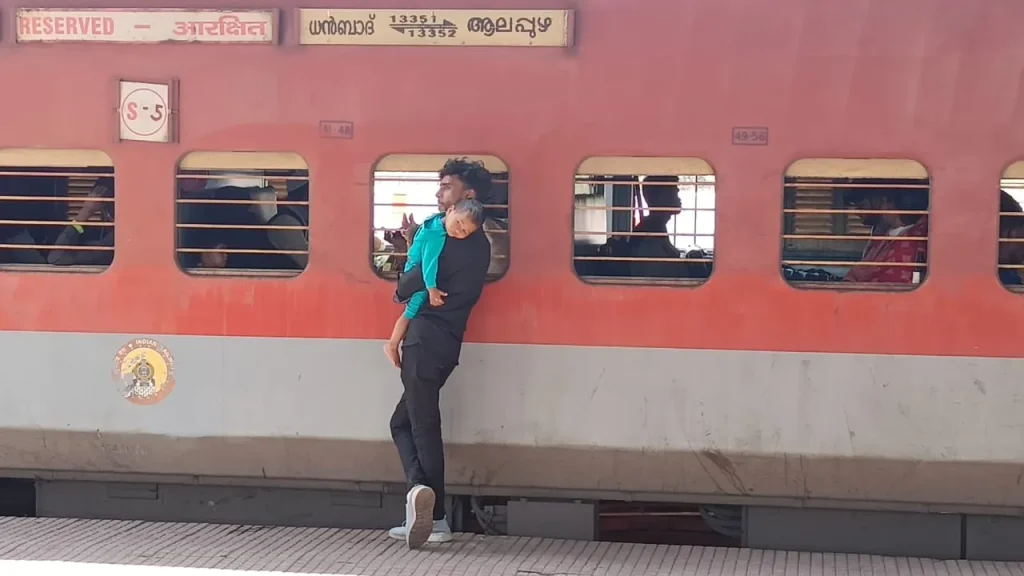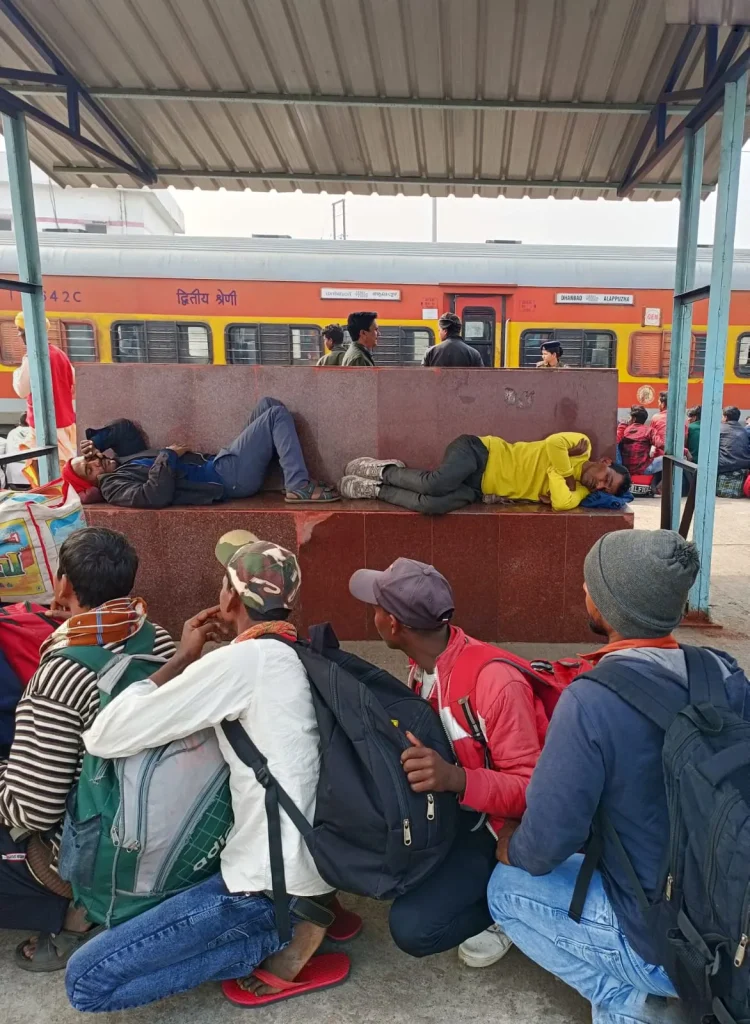Caste on the Move
by Divya Kamal
A reportage, surveying the journey of migrant workers from rural Jharkhand to Chennai, questioning the rural–urban divide and tracing the impact of caste and tribal identity on their mobility and aspirations.

Migrant labourers waiting to board the Dhanbad–Alappuzha Express. Dhanbad Railway Station, 2023.
Courtesy of Author.
At Dhanbad Railway Station in Jharkhand, John Marandi, a 24-year-old migrant labourer waits in a queue of around 200 passengers—most of them squatting, watching the police personnel guard the two general bogies of the Dhanbad–Alappuzha Express. Blowing loud whistles, shouting, and wielding their lathis, the policemen consistently ensure that there isn’t any stampeding or overcrowding in the coaches. John and his five friends eagerly wait to sprint towards the general bogies and secure berths for themselves and their friends, who will comprise their new family during the impending months in their destination town, Chennai. All of them hail from Latani, a minuscule village in Dhanbad with a population of 148 (as per the 2011 Census of India report), of whom 72 are men, with most of them migrating seasonally, throughout the year.
On being questioned about the reason for leaving his village and going to Chennai, John explains, “Majdoori achha milta hain wahan. Yahan, sheher (Dhanbad) mein dihaadee 280 Rupya milta hai, magar wahan Chennai mein din bhar ka 340-350 Rupya mil jaata hai.” (Labour wages are better there. Here, in Dhanbad, daily wages are 280 Rupees, but in Chennai, they are 340-350 Rupees.) He further adds, “Gaon mein to 200 bhi nhi milta hai din bhar kaam karne ka.” (In the village, we are paid not even 200 Rupees for a day’s work.)
When asked what work they would take up in Chennai, John pauses briefly before answering, “Raj Mistri.” His friends repeat after him, stuttering, “Raj Mistri.” John adds, “Abhi to Raj Mistri ka kaam sikhe hain, magar ab wahan jo bhi kaam mil jaye, kar lenge. Ek Seth Sahab hain, unke paas hi jaayenge, achhe aadmi hain, wo kuch kaam denge.” (Recently, we learned the work of Raj Mistri (a person who has mastered construction skills.) Whatever work we will get, we are willing to do it. I know a Seth Sahab (someone wealthy). He is a good man. He will give me some work.)
John belongs to the Oraon/Uraon community, which falls under the Scheduled Tribes (STs). These communities traditionally depended on forests and farmlands for their ritual practices and livelihoods. However, some of them have become settled agriculturists now while others like Marandi are compelled to migrate. Studies suggest that poverty, debt, lack of employment opportunities constitute some of the primary reasons for the out-migration of tribals from Jharkhand.
One of the window seats of the same train is occupied by Muniya. It is her first trip to Chennai, which she calls ‘videsh’ (foreign land). She is with her husband, Rahul Hansda, and their 3-year-old son. It is Hansda’s second trip to Chennai; he stayed there for four months last year. Though he is happy about his family accompanying him, he isn’t very confident about how Muniya will adapt to city life. He anxiously says, “Wahan hum khud hi itna pareshaan hote hain, yeh log to aur honge.” (Even for me, it is challenging there, so it will be even more difficult for them.) Muniya quickly interrupts him, saying, “Gaon mein akele thodi na achha lagta hai. Wahan videsh hi dekh lenge.” (It doesn’t feel good to be alone in the village either. At least, I will see foreign land.) Although unsure about the work she’ll find, she hopes to work alongside her husband at construction sites. She has previously worked in brick kilns near her village, Lehra Basti, and is open to working in affluent households (Babu log ke ghar).

Rahul Hansda holding his three-year-old son. Dhanbad Station, 2023.
Courtesy of Author.
A study by the Society for Regional Research and Analysis reveals that even in developed cities like Chennai, migrant labourers face hardships, which, for tribal women, often become extreme. They generally end up working at construction sites where they are subjected to economic and physical exploitation. They are often recruited through middlemen who offer meagre wages. Sexual harassment and assault are rampant. Illiteracy and language barriers prevent them from seeking help or expressing grievances. Fatal accidents are also common, and deductions from wages further perpetuate the cycle of poverty. Without essential documents like ration or voter cards, they remain miserably trapped in a loop of abuse and exploitation.

Passengers waiting in queue for the coach gates to open. Dhanbad Railway Station, 2023.
Courtesy of Author.
Like numerous other migrants, John, Rahul, and Muniya embark on such relentless journeys, compelled by impoverishment, lack of opportunities, and social discrimination. They spend their lives oscillating between their native homes and workplaces in towns throughout the year. Despite these journeys, their social status remains largely unchanged. Although migration helps them fulfill their immediate needs, in the long run, it becomes difficult for most of them to bear its true cost.
Marginalisation, Home, and the Periphery
Identity-based discrimination has persisted in Indian society for many centuries, along with religious and gender-based discrimination. Identity acts as a yoke, limiting some communities to specific menial work that their forefathers have been doing for eons. This occupational segregation at the village level is more stringent, ostracizing lower caste members and tribal communities, limiting their economic aspirations, and robbing them of their dignity. Although more prominent in villages, it follows and takes root wherever they migrate, depriving them of basic self-respect and autonomy.
After years of tribal revolts and agitation, the state of Jharkhand was carved out of Bihar in the year 2000, and even after more than 23 years since its formation, it still has the highest rate of rural out-migration in India. Every year, for months, it loses its skilled and unskilled workforce to other states, with families getting fragmented. Ironically, the tribal communities who participated in longstanding movements for the state are now migrating to different states in search of work.
In 2000, 35.4% of the SC population was below the poverty line in rural areas as against 21% among others (meaning non-SC/ST). In urban areas, the gap was even greater—39% of SC against only 15% among others. Although the village economy is usually small, it is still big enough to sustain marginalized communities, provided they are not excluded from their village, are allowed to participate in the village economy freely, like other communities, and are not subjected to violence and discrimination, which makes it difficult to tap into them as resources and capitalize.
Pushed to the peripheries, migrants like John and Rahul are caught in a perpetual struggle that diminishes their aspirations and propagates a circuit of desperation instead. Not much has changed since Dr. B. R. Ambedkar’s first meeting with Mahatma Gandhi at Mani Bhavan in Mumbai in August 1931, when Gandhi tried to justify Congress’s work for the upliftment of the Depressed Classes while claiming Ambedkar to be ‘a patriot of sterling worth’ in the struggle for the homeland. Ambedkar had then replied, “Gandhiji, I don’t have a homeland.” Over 60 years have passed, and although there has been significant improvement in the status of the Depressed Classes, the huge scale of seasonal migration proves that this statement still holds. The marginalized are still looking for a land to live on, without being boycotted—a place to call homeland.
References:
About the author
Divya Kamal is a freelance journalist from Dhanbad, Jharkhand. With a PG Diploma in Journalism from the Asian College of Journalism, Chennai, Divya specializes in investigating grassroots social issues. His talents lie in crafting immersive narratives via multimedia elements, while offering fresh insights from his lived experiences. Divya’s storytelling includes photo stories and documentaries that attempt to amplify voices for positive change.
He is on Instagram: @divya_kamal03
